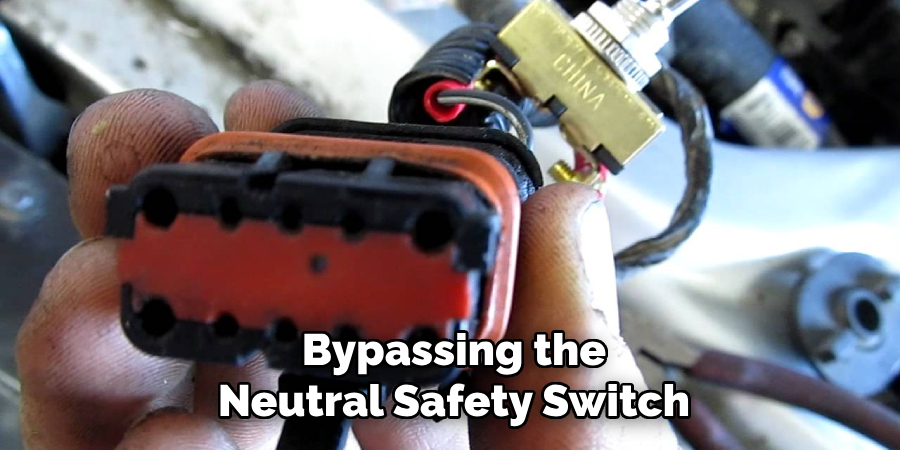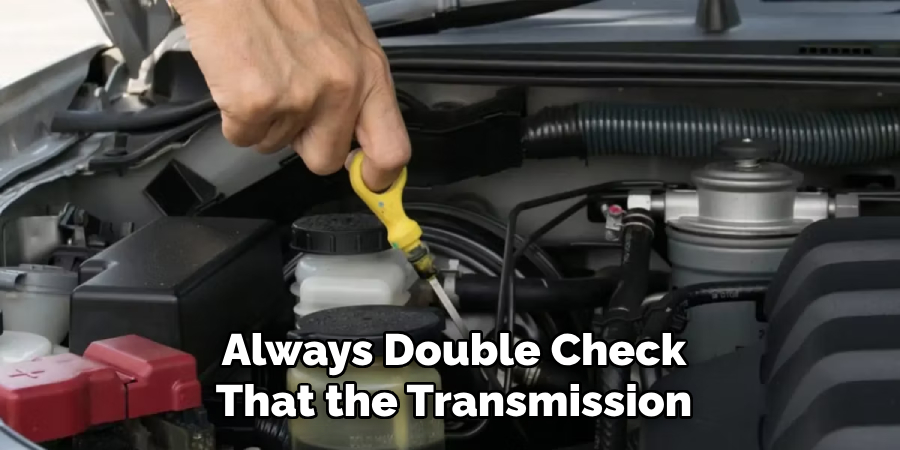Bypassing a neutral safety switch is a procedure often undertaken to troubleshoot or temporarily address issues related to starting a vehicle.

The neutral safety switch, also known as the clutch switch or inhibitor switch in automatic transmissions, prevents the engine from starting unless the transmission is in neutral or park.
Bypassing this switch involves overriding its function to start the engine regardless of transmission position, typically for diagnostic purposes or in emergency situations. While this procedure can provide a short-term solution, it is important to exercise caution and understand the implications for vehicle safety and operation.
Proper knowledge of the vehicle’s wiring diagram and safety precautions is essential to successfully bypassing the neutral safety switch without compromising overall vehicle functionality.
This guide explores the steps involved in how to bypass neutral safety switch, emphasizing safety and responsible use of this troubleshooting method.
Understanding Neutral Safety Switch Functions
The neutral safety switch serves a critical role in vehicle safety and operation. Its primary function is to prevent the engine from starting unless the transmission is in either neutral or park positions.
This is particularly essential for automatic transmissions, where starting the engine in any other gear could lead to unintended vehicle movement, posing significant risk to both the driver and bystanders.
In manual transmissions, a similar function is performed by the clutch safety switch, which prevents the engine from starting unless the clutch pedal is fully depressed, ensuring the vehicle remains stationary.
By integrating these safety features, vehicle manufacturers enhance operational safety, preventing mishaps that can occur due to human error.
Additionally, the neutral safety switch can also be involved in other vehicle systems. For example, in some vehicles, it communicates with the onboard computer to regulate engine timing and performance parameters.
Understanding the functionality and importance of the neutral safety switch highlights the need for caution and precision when considering bypassing this crucial component.

Differences in Application Between Automatic and Manual Transmissions
The application of the neutral safety switch differs between automatic and manual transmissions, reflecting the distinct mechanics and operational safety requirements of each system.
In automatic transmissions, the neutral safety switch is usually located on the transmission linkage or inside the transmission itself. Its primary role is to ensure the engine can only be started when the transmission is in the ‘neutral’ or ‘park’ position, preventing unintended vehicle movement.
On the other hand, manual transmissions rely on the clutch safety switch to perform a similar function by ensuring the clutch is fully engaged before starting the engine.
It is crucial to note that while similar in principle, bypassing these two switches require different approaches due to their location and wiring diagram.
This underscores the need for proper understanding of the specific system and associated safety procedures when attempting to bypass neutral safety switch.
10 Methods How to Bypass Neutral Safety Switch
1. Understanding the Neutral Safety Switch
Before attempting to bypass the neutral safety switch, it is crucial to understand its function and importance. The neutral safety switch prevents the engine from starting when the transmission is in gear, ensuring the vehicle does not accidentally lurch forward or backward upon starting.
Bypassing this switch removes this safety feature, increasing the risk of accidents. Understanding this will help you recognize the gravity of bypassing the switch and encourage you to take all necessary precautions.
2. Identify the Neutral Safety Switch Location
The first step in bypassing the neutral safety switch is to locate it. In most vehicles, the neutral safety switch is located either on the transmission or the clutch pedal assembly. Consult your vehicle’s manual to find the exact location.

Once identified, visually inspect the switch and the surrounding area to understand how it is connected to the transmission and the starter system. This knowledge is crucial for safely and effectively bypassing the switch.
3. Gather Necessary Tools
To bypass the neutral safety switch, you will need specific tools. These typically include a screwdriver set, a wrench set, wire strippers, electrical tape, and possibly a multimeter for testing.
Ensure you have all these tools on hand before starting the process. Having the right tools will make the job easier and reduce the risk of damaging any components during the bypass procedure.
4. Disconnect the Battery
Safety is paramount when working on your vehicle’s electrical system. Begin by disconnecting the battery to prevent any accidental shocks or short circuits. Remove the negative terminal first, followed by the positive terminal.
This will ensure that there is no power running through the vehicle’s electrical system while you are working on it, reducing the risk of injury or damage.
5. Access the Neutral Safety Switch
With the battery disconnected, proceed to access the neutral safety switch. Depending on its location, this may involve removing the gear shifter cover or parts of the dashboard or console.
Use your screwdriver and wrench set to carefully remove any panels or covers obstructing the switch. Take care not to damage any components during this process. Gaining clear access to the switch is essential for performing the bypass correctly.
6. Identify the Wires Connected to the Switch
Once you have access to the neutral safety switch, identify the wires connected to it. The switch will typically have two or more wires: one that goes to the ignition system and another to the transmission or clutch system.

Consult your vehicle’s wiring diagram if necessary to correctly identify these wires. Understanding which wires are which is crucial for successfully bypassing the switch without causing damage to other systems.
7. Create a Bypass Connection
To bypass the neutral safety switch, you will need to create a direct connection between the wires that control the starter relay. Strip a small section of insulation off the relevant wires using wire strippers.
Then, twist the exposed ends together to create a direct circuit. Secure the connection with electrical tape to ensure it stays in place. This bypasses the switch, allowing the vehicle to start regardless of the transmission position.
However, it is important to understand that this also removes the safety feature, making it essential to be extra cautious when starting the vehicle.
8. Test the Connection
Before reassembling everything, test the bypass connection to ensure it works. Reconnect the battery terminals and attempt to start the vehicle. If the engine starts successfully, the bypass has been completed correctly.
If it does not start, double-check your connections and wiring to ensure everything is properly secured. Testing at this stage ensures that the bypass is functional before you reassemble any components, saving you time and effort.
9. Reassemble the Components
Once you have confirmed that the bypass works, proceed to reassemble any components you removed to access the switch. Replace any panels, covers, or other parts, ensuring everything is securely fastened. Be careful not to pinch or damage any wires during reassembly.
Reconnecting everything correctly ensures that your vehicle’s interior is restored to its original condition and that there are no loose components that could cause issues later.
10. Understand the Implications and Take Precautions
Finally, it is crucial to understand the implications of bypassing the neutral safety switch. This modification removes an important safety feature, increasing the risk of starting the vehicle in gear and causing accidents.
Always double-check that the transmission is in neutral or park before starting the engine. Inform any other drivers of the vehicle about the bypass and its risks. Regularly check the bypassed connection to ensure it remains secure.

Understanding and mitigating these risks is essential for safe vehicle operation after bypassing the neutral safety switch.
Things to Consider When Bypassing a Neutral Safety Switch
Bypassing a neutral safety switch is a substantial alteration that affects the safety and functionality of your vehicle. Here are several key considerations to keep in mind:
- Legal and Warranty Implications: Modifying your vehicle to bypass safety features can have legal ramifications and may void your vehicle’s warranty. Always check local laws and your warranty agreement before proceeding with such modifications.
- Safety Concerns: The original purpose of the neutral safety switch is to prevent accidents by ensuring the vehicle starts only in neutral or park. Bypassing this switch removes this critical safety feature, significantly increasing the risk of unintended movement and potential accidents when starting the vehicle.
- Vehicle Resale Value: Modifying your vehicle in this way can affect its resale value. Potential buyers may view the bypass as a safety hazard and may offer less for the vehicle or choose not to purchase it at all.
- Informing Other Drivers: If other people drive your vehicle, it is essential to inform them about the bypass. This will ensure they exercise extra caution when starting the car, especially if they are unaware of the modification.
Conclusion
In conclusion, bypassing a neutral safety switch involves several detailed steps, including understanding the switch’s function, identifying its location, gathering necessary tools, disconnecting the battery, accessing the switch, identifying the connected wires, creating a bypass connection, testing the connection, reassembling components, and understanding the implications.
Each step requires careful attention to detail to ensure the bypass is completed safely and effectively. However, it is important to emphasize that bypassing the neutral safety switch is generally not recommended due to the significant safety risks involved.
If you choose to proceed, take all necessary precautions to ensure the safe operation of your vehicle.
About
Safety Fic is a distinguished figure in the world of Diy design, with a decade of expertise creating innovative and sustainable Diy solutions. His professional focus lies in merging traditional craftsmanship with modern manufacturing techniques, fostering designs that are both practical and environmentally conscious. As the author of diy, Safety Fic delves into the art and science of Safety Fic-making, inspiring artisans and industry professionals alike.
Education RMIT University
(Melbourne, Australia) Associate Degree in Design (Safety Fic) Focus on sustainable design, industry-driven projects, and practical craftsmanship. Gained hands-on experience with traditional and digital manufacturing tools, such as CAD and CNC software.
Nottingham Trent University
(United Kingdom) Bachelor’s in diyfastly.com and Product Design (Honors) Specialized in product design with a focus on blending creativity with production techniques. Participated in industry projects, working with companies like John Lewis and Vitsoe to gain real-world insights.
Publications and Impact
In diy, Safety Fic his insights on indoor design processes, materials, and strategies for efficient production. His writing bridges the gap between artisan knowledge and modern industry needs, making it a must-read for both budding designers and seasoned professionals.
